
23 minute read
The College of Health Sciences and the College of the Sciences and Mathematics over the course of 150 years
History and Heritage
150 years
Advertisement
As West Chester University marks its 150th year, we will continue to feature articles showcasing some of the pillars on which our institution’s foundation is built. In this issue, we look at the synergies in the sciences between the College of Health Sciences (CHS) and the College of the Sciences and Mathematics (CSM), as their collaborations continue to strengthen. For example: Michael Gawrysiak, an assistant professor of psychology in CSM who is also associated with CHS Contemplative Studies Center, recently received a National Institutes of Health grant to see if meditation helps individuals recover from opioid addiction. Read more on page 15. CSM’s pre-med B.S. program, whose graduates enjoy a 95 percent acceptance rate into a wide array of health professional schools, including medicine, dentistry, and veterinary medicine, also preps CHS graduates interested in applying to such schools — including to help organize documents and letters of recommendations, and with simulated medical school interviews. CSM has supported CHS in its rollout this fall of a physician assistant M.S. program. CHS kinesiologists are collaborating with faculty in CSM’s two-year-old bioengineering program. These collaborations will increase with the opening this fall of The Sciences & Engineering Center and The Commons. The $130-million, 176,000-square-foot center — the largestever building within the Pennsylvania State System of Higher Education — will house CSM’s Physics and Engineering Department as well as the Health, Nursing, and Nutrition Departments from CHS. Many thanks to the building’s lead donors: Founder, President, and CEO of ProMetrics Marc Duey, who gifted $1 million on behalf of the Duey family; Student Services, Incorporated (SSI), another $1 million donor whose chair of the board of directors is Bernie Carrozza ’66; and the West Chester University Alumni Association (WCUAA), which donated $150,000.
Benefactors and West Chester University officials formally broke ground in celebration of the immersive learning that will take place in the new Sciences & Engineering Center and The Commons. Pictured (L – R) are Laurie Bernotsky, executive vice president and provost; David James ’91, vice chairperson of the Student Services, Incorporated Board of Directors; Zebulun Davenport, vice president for Student Affairs; Joseph Kienle ’72, M’74, member of the Alumni Association Board of Directors; Christopher Fiorentino, WCU president; Radha Pyati, dean of the College of the Sciences and Mathematics; Marc Duey, founder, president, and CEO of ProMetrics; Scott Heinerichs, dean of the College of Health Sciences; and Christopher Mominey, WCU Foundation CEO.
women’s physical education 1908

COLLEGE OF HEALTH SCIENCES: PRODUCING MASTER’S-LEVEL HEALTHCARE PROVIDERS
Ninety-eight years ago, Elizabeth Tyson, a faculty member in the English Department of what was then the West Chester Normal School, launched one of the country’s first speech clinics. Then, 51 years ago, one of the nation’s finest athletic training degree programs began at West Chester. Those milestones are just two of the key developments that have pushed what is now the College of Health Sciences (CHS) far beyond just the normal school’s early interests in health and physical education. Established in 1979, CHS now boasts six departments: Communication Sciences and Disorders, Health, Kinesiology, Nursing, Nutrition, and Sports Medicine. “Over time, we have developed a college that is meeting the needs of society by preparing a wide range of allied health professionals,” says Scott Heinerichs ’99, the CHS dean who earned his B.S. in athletic training at WCU. This summer, the College will welcome its first Master in Physician Assistant Studies students. “Over the last 50 years the College has grown to offer a significant number of degree programs in a variety of allied health fields,” Heinerichs says.
nursing department 1979

athletic training 1984

“What excites me the most,” he adds, “is that, rather than being in silos, our students work together with students pursuing other healthcare degrees. That way, they understand what other professionals are also doing and understand the importance of collaboration to improve patient outcomes.” In addition, more healthcare profession licensures require, or will soon require, a master’s degree to practice professionally. CHS is meeting that higher bar with robust graduate-level degree programs. To make attaining those graduate degrees more accessible, the College also offers accelerated master’s degree programs in athletic training, communication sciences & disorders, exercise science, public health, and nutrition. Clearly, based on the first-time pass rates for board licensure exams, CHS students are prepared for their professions. Three CHS programs — athletic training, communication sciences & disorders, and nursing — are experiencing extremely high firsttime pass rates of 88-100 percent on board exams. “Our graduates’ outstanding first-time exam pass rates demonstrate the commitment to excellence that both our faculty and students share in developing talented frontline healthcare workers,” says Heinerichs.
PROFESSOR EMERITUS PHIL DONLEY: WCU’S ATHLETIC TRAINING PROGRAM TRAILBLAZER
Phil Donley, who arrived in 1965 as an associate professor of health and physical education, hired the first female college athletic trainer in the United States, made the athletic training (A.T.) program one of the first in the U.S. to go co-ed, and led the program to be just the fifth A.T. program in the country to be accredited by the National Association of Athletic Trainers. “Working with the coaches, it was the perfect laboratory to work to improve health standards for athletes, particularly female athletes,” he recalls. “Gradually, more of the phys ed students saw what A.T. services provided and wanted to do that.” Donley was instrumental in transforming what was then a program that focused on providing A.T. services to athletes into an academic major, a shift that ultimately led to the creation of the Department of Sports Medicine in 1991.
One example: WCU’s joint Respiratory Care Program with Bryn Mawr Hospital is one of only eight such educational programs nationwide awarded the American Association for Respiratory Care’s 2020-2021 Apex Recognition Award. Additionally, public health students deepen their expertise through the opportunity to intern with more than 100 organizations. Many students — both graduate and undergraduate — also assist their professors in research. “Over the past 15 to 20 years, our faculty have found ways to engage students, including getting them involved in conference presentations and published peer-reviewed scientific papers, in both experimental design research and research that has a direct impact on our community,” says Heinerichs. “For example, our nutrition students have taught middle schoolers at the local YMCA how to cook healthy on a budget, and our public health students have worked with area hospitals on a colorectal screening study.” Ken Clark M’09, associate professor of kinesiology, returned to WCU in 2015 after completing his Ph.D. in biomechanics at Southern Methodist University. His research focuses on improving athletic performance, including strength & conditioning and speed development. He has consulted with USA Track & Field and several NFL teams. “At West Chester,” he says, “we’re able to get involved with the students and athletes in so many different contexts: in the classroom, in labs, with the Exercise Science Club, on the field or court, and participating together in research. We’re able to get to know them in so many different ways and greatly influence their careers.” Nicole Cattano M’04, associate professor of sports medicine, has worked within WCU’s Sports Medicine Department ever since earning her master’s degree — even while completing her Ph.D. in kinesiology at Temple University. “The athletic training program has such a rich history and legacy nationally within the profession,” says Cattano, who directs the post-professional master of science in athletic training. “Our students conduct high-quality research while completing interdisciplinary coursework.” The athletic training program is one of the few nationwide not affiliated with a medical school to offer graduate students a cadaver lab with integrated technology. “It’s like giving our students a super power,” she says. “When an athlete complains of knee pain, you have such an indepth understanding of all of the knee’s structures that it really helps your clinical reasoning and diagnosis.” Three years ago, Chiwoneso Tinago, assistant professor of health, and colleagues at the universities of South Carolina and Zimbabwe were awarded a $100,000 Grand Challenges Explorations Grant from the Bill and Melinda Gates Foundation. The purpose: to develop and test a community-based peer support intervention for adolescent mothers in Harare, Zimbabwe’s capital.



sturzebecker Health Science Center

Tinago, the principal investigator, hails from Harare. After an 18-month pilot program proved successful in reducing depression among the 14- to 18-year-old mothers, she is seeking funding to scale up the program in Zimbabwe and similar developing countries. The 2019 CHS Faculty Vision Award winner also founded and chairs the CHS Global Health Research Team, which now includes 10 faculty members; the team was supported by one of the first grants from CHS’ International Initiative Grant Program. Tinago also co-directs WCU’s Uganda Program, a 10-day servicelearning program in which mostly underrepresented students of color worked with a grassroots organization providing health care and social services. “What we learn globally can have local impacts,” says Tinago. “Some of the nearly 20 students who went to Uganda in 2018 and 2019 returned and worked with the Chester County Food Bank and the Philadelphia and Pennsylvania departments of health.” Looking forward, for half a century the South Campus’ Sturzebecker Health Science Center — named for the late Russell L. Sturzebecker ’37, the long-time chair of the Health and Physical Education Department — has been the “capital” of the College of Health Sciences. This fall, however, with the opening of The Sciences & Engineering Center and The Commons on North Campus, some of the College will shift northward. Besides housing the dean’s office and the Health, Nursing, and Nutrition Departments, as well as the Physics Department and the new Biomedical Engineering program, the $130-million building will feature a large immersive learning center that will offer students simulated patient encounters, including a home healthcare suite. A nutrition lab will operate next to the student dining hall and a state-of-the-art environmental health lab. “It will really allow us to leverage the latest technologies and best-practice simulations,” explains Heinerichs. “Combined with renovations to Sturzebecker, CHS will soon have the state-of-the-art facilities to elevate our programs even further into the 21st century.”
west chester normal school science lab
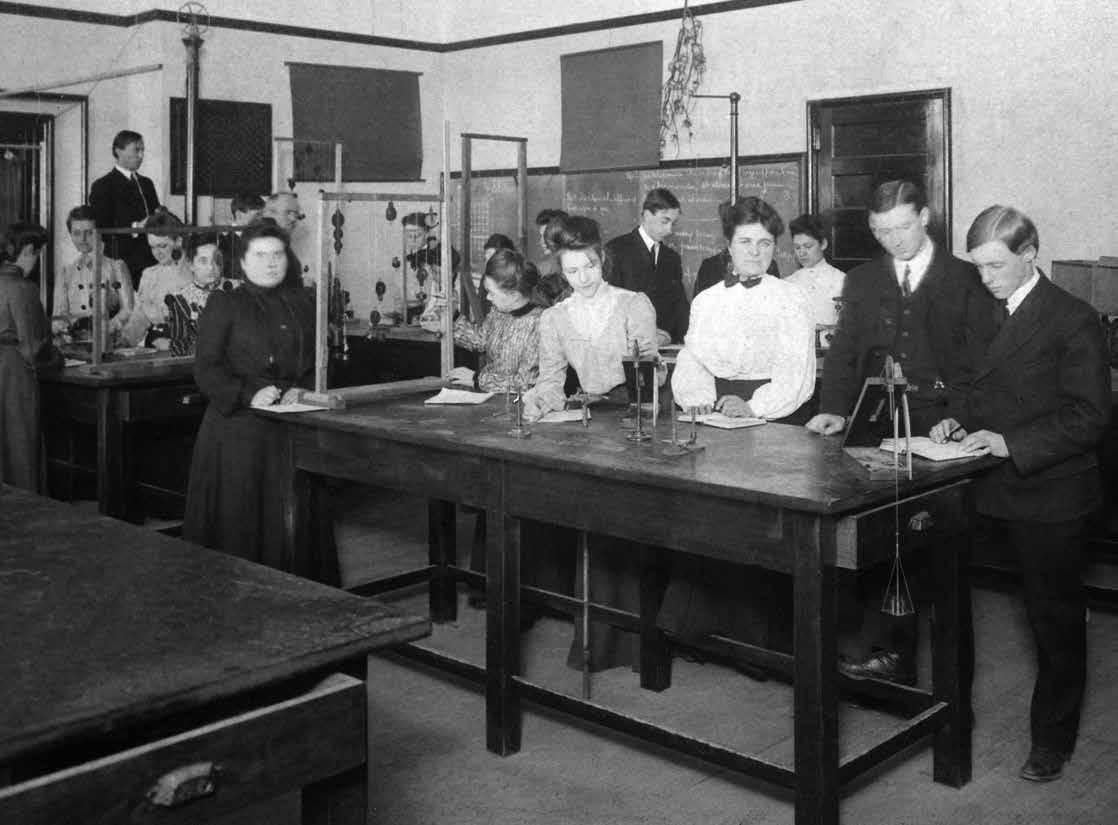
COLLEGE OF THE SCIENCES AND MATHEMATICS: DEVELOPING STUDENTS WHO CHANGE THINGS
The West Chester Normal School once instructed students how to teach science. Today, professors and many College of the Sciences and Mathematics (CSM) students are also doing science.
“West Chester conducts science on a level that really puts our students among their peers at any institution,” says Radha Pyati, an analytical chemist and dean of the College of Sciences and Mathematics. “We are attracting top-notch faculty who want to do cutting-edge science with their students. “Both undergraduate and graduate students have the opportunity to use state-of-the-art technology and equipment. They also have the chance to add to the body of science by publishing their work in high-impact journals that are read by scientists worldwide.”
chemistry lab

mathematics class
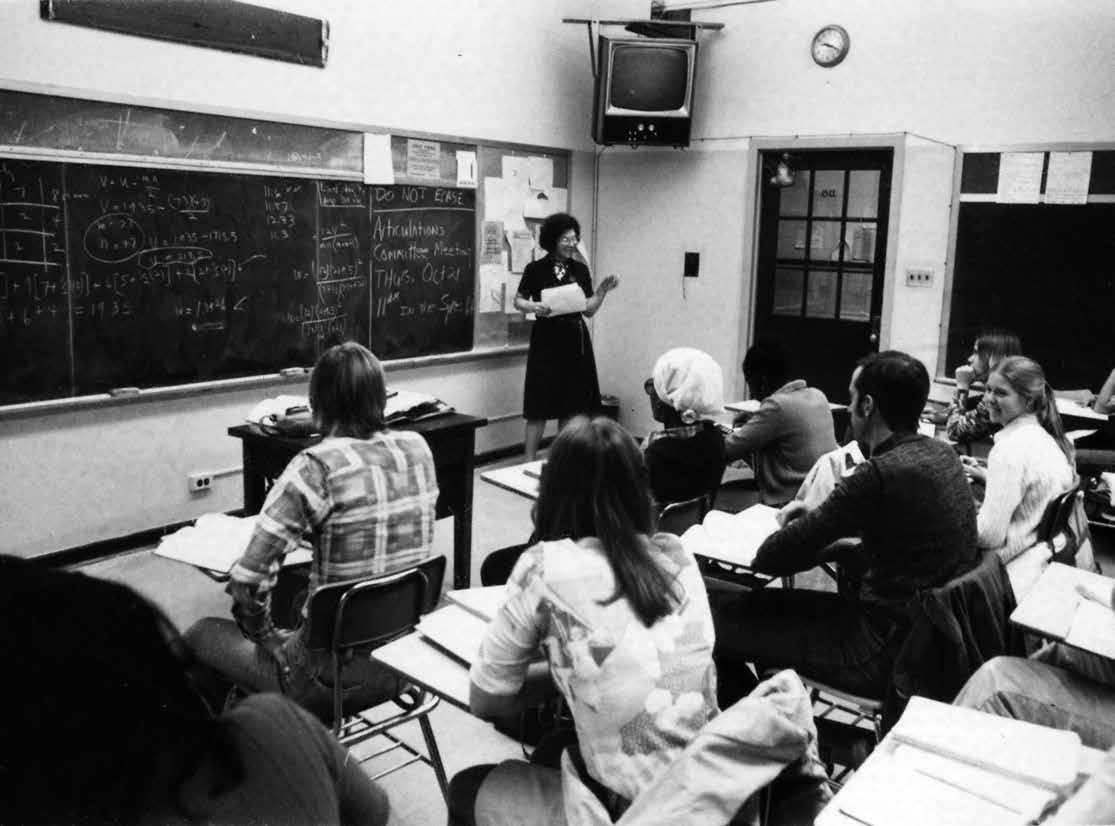
In collaboration with their professors, CSM students are also conducting research that can make a difference in our communities. For more than 10 years, hundreds of students of Psychology Professor Ellie Brown have assisted in her research, supported by the National Endowment for the Arts, with Head Start children. Measuring their cortisol levels, they have demonstrated that engaging in the arts lowers emotional stress levels of economically disadvantaged preschoolers.
Just five years ago, an academic reorganization created CSM. Its nine departments — Anthropology and Sociology, Biology, Chemistry, Computer Science, Earth and Space Sciences, Mathematics, Physics and Engineering, Political Science, and Psychology — were separated from what is now the College of Arts and Humanities.
“It’s enabled us to further concentrate our focus on science and, since then, the amount of interdisciplinary research has skyrocketed,” says Vishal Shah, CSM associate dean. He and Brandon Mitchell, assistant professor of physics, are the co-principal investigators who are working with other WCU coinvestigators on a new $1 million National Science Foundation (NSF) Scholarships in STEM Program grant. It will fund and help assess the impact of scholarships and extensive academic support for 16 academically talented, low-income STEM majors. (Pyati also recently hosted a virtual STEM workplace conference for students and early career professionals that focused on women and people of color.)
The NSF funding is just the latest in a series of highly competitive federal grants secured by CSM faculty that are advancing science while raising WCU’s profile nationally among both prospective students and faculty.
Other recent major federal grant recipients besides Brown include: Frank Fish, professor of biology, who explores the locomotion dynamics of aquatic animals — with funding from the NSF, Office of Naval Research and the Defense Advanced Research Projects Agency.
Kurt Kolasinski, professor of chemistry, whose research into nanostructuring of metals induced by lasers, and semiconductors by electrochemistry, is mostly funded by the NSF.
Jess Sullivan-Brown, assistant professor of biology, who acquired a high-powered confocal microscope via a 2018 NSF grant — in part to further her study of neural tube defects, such as spina bifida.
“The acquisition of Sullivan-Brown’s confocal microscope really boosted our ability to conduct science and familiarize our students with cutting-edge instrumentation,” says Pyati. In both their teaching and research, CSM professors continue to demonstrate how science has real-world impacts. For example, Lisa Marano, professor of mathematics and special assistant to the dean, shows her students how mathematics can advance social justice. “Instead of looking at sports statistics, I show them how they can use mathematics to prove that injustices really are occurring and effect change in their communities,” says Marano, who is also codirector of WCU’s First Year Experience. “Whether you are looking at predatory lending practices, incarceration rates or the conviction rates of Black defendants by all-white juries, the statistics are powerful.” Over the past three years, two grants — $30,000 from the National Geographic Society and $6,000 from the National Endowment for the Humanities — have funded interdisciplinary research by Heather Wholey, professor and Department of Anthropology and Sociology chair, and Daria Nikitina, professor of geology. Their goal: identify thousands of archeological sites along the edge of the Delaware Bay that are at risk for being inundated by rising sea levels triggered by climate change. Their investigations have simultaneously engaged multiple earth and space science graduate students and more than a dozen undergrads from both disciplines. “Working in the field and conducting data analysis is important for their professional development,” says Wholey. “And with many students concerned about both the environment and cultural heritage, the research is extremely relevant.” Three years ago, the testimony of John J. Kennedy, professor of political science, helped convince the Pennsylvania Supreme Court to redraw the state’s congressional districts because they unfairly violated the state constitution: “The first time in American history,” Kennedy notes, “that a legislative map had been struck down for political gerrymandering.” Kennedy was called as a witness because, since his 1997 arrival at WCU, he has authored four books on Pennsylvania government and politics. “I’ve received a tremendous amount of support over the years, both from my colleagues and the administration,” he says. “It’s a vibrant institution that hits the sweet spot for me between teaching and research. I’m fortunate to be surrounded by such accomplished students and faculty.” Meanwhile, CSM is meeting students’ and employers needs with a variety of majors. For example, interest in computer science has never been higher. During the past 10 years, the number of undergraduate majors (416) nearly quadrupled and M.S. candidates (38) more than doubled. Graduate programs range from an M.S. in applied statistics to the Doctor of Psychology in Clinical Psychology (Psy.D.) degree program launched in 2016. The accredited Psy.D. program also illustrates how CSM benefits the community. In conjunction with the doctoral program, WCU Community Mental Health Services opened a clinic in 2017 as a non-profit training and research facility. Supervised by licensed clinical psychologists, Psy.D. students provide affordable mental health services to both campus community members and the public. Patients include children and adolescents, or those suffering from trauma, the two areas on which Psy.D. candidates focus.
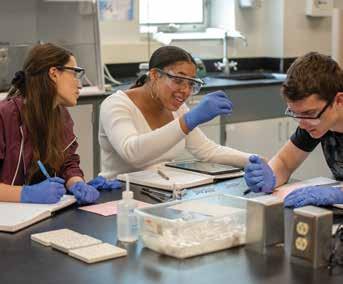
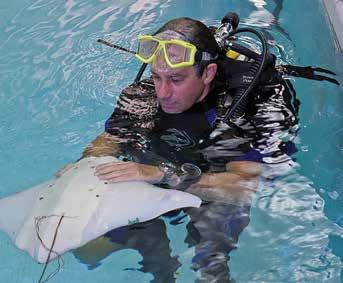

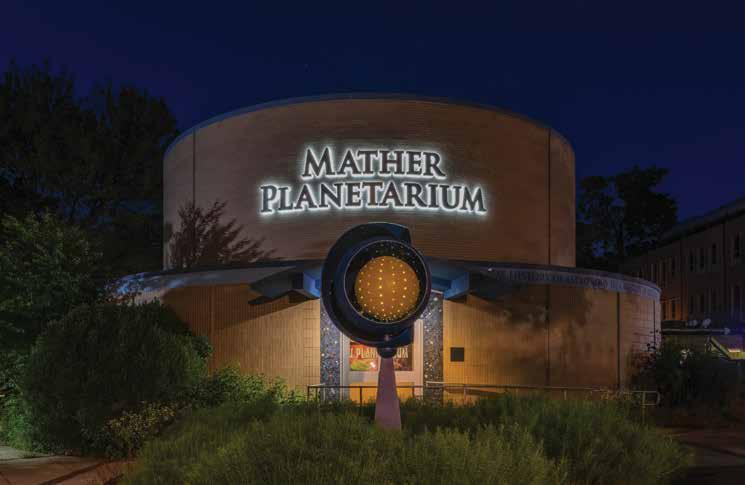
Other CSM community resources include the Dr. Sandra F. Pritchard Mather Planetarium, the WCU Museum of Anthropology and Archaeology, and the Geology Museum.
This fall’s opening of The Sciences & Engineering Center and The Commons, which will become the new home of the Department of Physics and Engineering, represents a new chapter for CSM. Pyati believes the building, as well as the Biomedical Engineering B.S. program, which welcomed its first students in 2019, represent significant enhancements of WCU’s science capabilities.
“Biomedical engineering is a real game changer,” says Pyati. “We selected it to be our first engineering specialty for several reasons. It attracts a diverse student population, including women. Also, considering that the biomedical and pharmaceutical industries are so strong in the Philadelphia region, we believe we are developing a new kind of professionally educated student to contribute to a new, really exciting field.
“The fact that we have received such tremendous philanthropic support for the program and the new building underscores their value.”
PROFESSOR EMERITA SANDIE MATHER: THE EPITOME OF A TEACHER-RESEARCHER
Sandra (Sandie) F. Pritchard Mather ’64, M’68 spent 11 years as a second-grade teacher and assistant professor in WCU’s K-6 laboratory school, and 18 years as an assistant, associate, and full professor in the Department of Earth and Space Sciences before retiring in 1999.
Since then, she has noticed that her department, as well as all of CSM, has become more student oriented and more focused on the teacher-researcher model. “Being a teacher-researcher brings excitement to your teaching because you’re out there in the field,” says Mather, who has authored and co-authored 24 books about the geology, geography, and history of mountainous Summit County, CO. “I always thought about how I could bring my research into my teaching.”
“Community outreach has also increased,” added Mather, who in 2013 funded the renovation costs of the planetarium that now bears her name — a planetarium that, pre-pandemic, annually hosted 3,000 school children and adults.
Next issue’s 150th anniversary history feature will focus on the College of Education and Social Work.
Christine Karpinski ’89
Christine Karpinski ’89 Explores Innovative Sports Nutrition for WCU Student-Athletes

Ever since Christine Karpinski’s mother insisted that she eat right as a high school athlete in Pottstown, PA, Karpinski has explored the intersection of exercise physiology and nutrition — a field that barely existed when she began her investigations. Karpinski played field hockey and lacrosse at WCU while earning a B.S. in exercise science. A decade later, after earning an M.A. in nutrition education from then-Immaculata College, she returned to WCU in 1999 as a part-time adjunct professor — and subsequently earned her Ph.D. in health science nutrition from Rutgers University while continuing to teach. Today, besides serving as the chair and professor of the Department of Nutrition, she is an exercise physiologist, registered dietitian, and a board-certified specialist in sports dietetics. She also chairs the Sports, Cardiovascular, and Wellness Nutrition dietetic practice group (SCAN) — a 5,000-member dietetic practice group of the Academy of Nutrition and Dietetics — and is the editorin-chief of the latest edition of Sports Nutrition: A Handbook for Professionals. Each day, WCU’s student-athletes benefit from both Karpinski’s nationally renowned expertise and the ongoing research that she and her students are conducting. Their focus: WCU athletes’ own nutritional behaviors. Her WCU Sports Nutrition Education and Fueling Program, which is part of the WCU Student Athlete Success Program, guides athletes toward healthier food choices. It includes fueling stations with nutritious snack options around practices and games, and “Go Bags” during game trips or when the athletes are rushing between practices and evening classes. Educational components include team talks, individualized counseling, and even cooking demos. “Although common at Division I programs, what we do with our student-athletes just doesn’t exist in most Division II sports programs,” says Karpinski, who has launched an endowment to help fund the program. “About a dozen of my D-II colleagues have adopted my model, as have some D-III schools. “I love what we’re doing here because the athletes think it’s so cool and feel so special.” The research that she and her students conduct doesn’t, per se, measure athletic performance. Rather, she says, “We might evaluate whether our sports nutrition program leads athletes to eat more fruits and vegetables. That might not necessarily improve their performance during the next game, but a healthier diet is the foundation for a strong immune system and contributes to mental health — important factors for our student-athletes’ overall health and wellness. That’s as important as winning or losing a game.” Karpinski appreciates being at WCU because, she said, “It’s the perfect size for me: not too small and not too big. When I was a student, it really made a difference for me because my professors really cared and were able to engage with me. Now that I’m on the other end, that’s still true today. “I like being a practitioner, working with athletes on sports nutrition,” she added, “but I also consider it a calling to teach tomorrow’s professionals. That’s what I love doing.”
Michael Gawrysiak

Gawrysiak Using $417,000 NIH Grant to See If Meditation Helps Individuals Recovering from Opioid Addiction
Earlier this year, Michael Gawrysiak, assistant professor of psychology, was awarded a three-year, $417,000 grant from the National Institute on Drug Abuse (NIDA) to determine if meditation and other mindfulness strategies can benefit recovering opioid drug abuse patients. Specifically, he is exploring whether Mindfulness-based Relapse Prevention (MBRP) techniques can help former opioid users better adhere to their preventative medications and better avoid opioid relapses. “The opioid epidemic is killing so many people,” says Gawrysiak, “and this is one of the first large-scale attempts to gauge the effectiveness of combining medication and behavioral treatments to address the crisis.” Gawrysiak has been interested since high school in how both meditation and drug use can alter our brains’ behavior. Regarding meditation, he says, “It’s always intrigued me how we can change our behaviors and attitudes simply by sitting quietly and becoming more aware of what’s really going on in our minds.”
Gawrysiak earned a B.A. in psychology from the University of Southern Illinois, Carbondale in 2005, and both his M.A. in experimental psychology (2008) and his Ph.D. in clinical psychology (2011) from the University of Tennessee, Knoxville. A pre-doctoral one-year internship at the Jesse Brown VA Medical Center in Chicago and a three-year postdoctoral fellowship working at the Philadelphia VA Medical Center and University of Pennsylvania Perelman School of Medicine proved to be critical experiences for his advanced training in mental illness research and treatment. He was struck by how often veterans suffering from post-traumatic stress disorder (PTSD) had become addicted to alcohol or drugs. “Our brains become hard-wired to know that drugs can be a relief, an easier but problematic way to cope with our problems,” he says. At the Philadelphia VA, he started mindfulness groups for PTSD and patients struggling with addiction, as well as for VA staff to help them deal with their stressful jobs. Simultaneously, he also sharpened his focus on addiction and mindfulness through his research within the Center for Studies of Addiction at the University of Pennsylvania and as a mindfulness instructor through the Penn Program for Mindfulness. Gawrysiak joined WCU in 2017; his wife Stevie Grassetti, another assistant professor of psychology, followed him a year later. In 2019-20, he piloted the MBRP concept that NIDA is now funding with a nearly $10,000 2019-20 WCU Provost Research Grant. He and three to five of his graduate students in the clinical psychology doctoral program will be conducting a clinical trial involving 200 patients at Gaudenzia, Inc.’s residential treatment facility in West Chester. “I will be training them in MBRP and eventually they will be administering the treatment on their own,” says Gawrysiak, who relishes the opportunity to involve WCU undergraduates in his research. “Mentoring students towards tangible professional growth is so rewarding.”
David Holveck ’68
Retired Pharmaceutical Executive Dave Holveck ’68 Continues to Give Back

To see how far a WCU degree can take you, consider Dave Holveck ’68. After graduating with a B.S. in physical education and serving two and one half years in the U.S. Navy, he embarked on a truly impressive health-related business career. His more than 40 years in pharmaceuticals included serving as the president and CEO of Centocor, a Malvern-based biotech firm; the president of Johnson & Johnson’s Development Corporation after J&J acquired Centocor; and president, CEO, and director of Malvern-based Endo Pharmaceuticals — from which he retired in 2013 after more than doubling its annual revenues to $3 billion in just five years. “I was very fortunate to be able to tie a lot of my business experiences to major innovations in healthcare, including nuclear medicine for both imaging and treatment, computer tomography and MRI with General Electric; immunoassays with Abbott Laboratories; and monoclonal antibodies with Centocor,” says Holveck, whose passion for science was piqued by his college life science courses. Building upon that expertise, in 2000 he helped what is now the College of the Sciences and Mathematics launch the cutting-edge B.S. in pharmaceutical product development (PPD) degree, one of the first such programs on the East Coast to prepare students for pharmaceutical and biotech careers. “The pharmaceutical industry is so strong in the Philadelphia area and it’s always in need of college graduates who can quickly assimilate both the science and necessary management skills to develop, manufacture, and deliver beneficial products.” The PPD program is just one of the many ways that he and his wife Pat ’69 have given back to WCU. Dave, a Distinguished Alumnus (2007) and Sturzebecker Hall of Fame inductee (2010), is also a former member of the CHS Advisory Board and the boards of the WCU Foundation and the Pennsylvania State System of Higher Education. Pat, who earned her B.S. in early and middle grades education and worked in the special education field, was the 2008 President’s Circle Award winner. The Holvecks, often through her Lightening the Load Foundation, regularly support the University’s Promise Program, the Resource Pantry, the Student Emergency Aid Fund, and the Annual Presidential Scholarship Community Gala. Since his retirement, Holveck has also contributed his business acumen to nonprofits, including serving as a trustee of Children’s Hospital of Philadelphia; the immediate past chair of the Kimmel Center; and director emeritus of the University City Science Center. “I’m attracted to working with people who have insight, vision, and passion,” he explains. As for his continued support of WCU, he said, “I’m quite impressed with what West Chester is doing in terms of bringing healthcare and the sciences together along with health education. Overall, West Chester is really growing in stature. It offers students the opportunity to get a very good education and a promising career at a very reasonable cost.”



